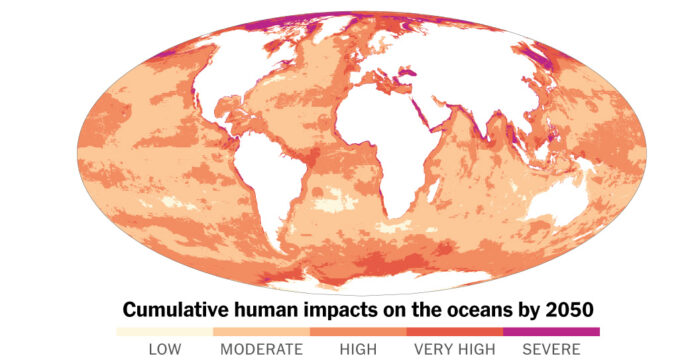"Preserving Our Coastal Heritage: The Fight Against Oceanic Change and Cultural Erosion"
New Study Reveals Alarming Changes to Coastal Marine Ecosystems
By Delger Erdenesanaa
Graphics by Mira Rojanasakul; Photographs and Video by Madeline Gray
Published: September 4, 2025
Source: Halpern et al., Science (2025)
On a sweltering summer day at St. Helena Island, South Carolina, Ed Atkins, a Gullah Geechee fisherman, pulled in a five-foot cast net, revealing glossy white shrimp from the salt marsh. For 40 years, Atkins has operated a bait shop established by his parents in 1957, a testament to a way of life deeply intertwined with the coastal ecosystem. “When they passed, they made sure I tapped into it and keep it going,” he remarked, highlighting the cultural significance of fishing in his community.
However, a new study published in Science has raised alarms about the future of such coastal habitats. The research, led by marine biologist Ben Halpern from the University of California, Santa Barbara, indicates that human activities are drastically reshaping oceans and coastlines, putting marine ecosystems at unprecedented risk.
The Vulnerability of Coastal Ecosystems
The study identifies salt marshes, seagrass meadows, rocky intertidal zones, and mangrove forests as some of the most vulnerable marine habitats. These ecosystems are crucial not only for biodiversity but also for providing natural defenses against storm damage and supporting commercial and recreational fisheries that sustain over two million jobs in the United States alone.
Halpern describes the situation as “death by a thousand cuts,” warning that if pressures like climate change, overfishing, ocean acidification, and coastal development continue unchecked, many marine ecosystems could be fundamentally altered by mid-century. “It’s going to be a less rich community of species. And it may not be something we recognize,” he added.
Cultural Implications
The cultural richness of communities like the Gullah Geechee people is also at stake. Marquetta Goodwine, the elected head of the Gullah Geechee Nation, emphasizes the deep connection between their culture and the coastal environment. “We have our own language, we have our own food ways, we have our own ecological system,” she stated. The loss of marine resources would not only impact livelihoods but also erode the cultural identity tied to these ecosystems.
Methodology of the Study
The research began in the early 2000s amid rising concerns over coral bleaching. The team developed an impact score to assess the health of various marine habitats based on human pressures and vulnerabilities. Their findings suggest that by 2050, approximately 3% of the global ocean could change beyond recognition, with nearshore areas facing even greater risks—over 12%.
Regions like tropical and polar seas are expected to experience more pronounced effects, while countries heavily reliant on marine resources, such as Togo, Ghana, and Sri Lanka, are identified as particularly vulnerable.
Key Findings
-
Major Pressures: The study highlights ocean warming and overfishing as the most significant threats to marine ecosystems. The researchers caution that their models may have underestimated the impact of fishing, as they did not account for bycatch or habitat destruction from practices like bottom trawling.
-
Cumulative Effects: The study notes that the combined effects of various human activities could be more damaging than previously thought. Mike Elliott, a marine biologist not involved in the study, agrees that the cumulative impacts are likely to exceed current estimates.
- Future Projections: If current trends continue, scientists predict a significant decline in biodiversity, with fewer resilient species able to withstand climate change and other pressures.
Conservation Efforts
In response to these alarming findings, initiatives like the global effort to protect 30% of the world’s land and seas by 2030 are gaining traction. In South Carolina, the ACE Basin—a 350,000-acre wetland—has been designated for conservation, showcasing the potential for large-scale protective measures.
Local efforts include the construction of “oyster castles” to stabilize coastlines and promote habitat restoration. These projects, often involving community volunteers, aim to enhance resilience against erosion and sea-level rise.
Community Resilience
Despite the challenges, communities are actively engaging in conservation efforts. The Sweetgrass Festival in Mount Pleasant, SC, celebrates Gullah Geechee culture, showcasing traditional basket weaving and other crafts. However, artisans like Henrietta Snype express concerns over the changing environment, noting the diminishing availability of materials like sweetgrass.
“The times bring on a lot of change,” Snype reflected, emphasizing the need for awareness and action to protect both cultural heritage and marine ecosystems.
Conclusion
The findings of Halpern et al. serve as a clarion call for immediate action to safeguard coastal marine ecosystems. As communities like the Gullah Geechee navigate the complexities of environmental change, the interplay between cultural identity and ecological health becomes increasingly vital. The time to act is now, as the future of our oceans—and the communities that depend on them—hangs in the balance.
